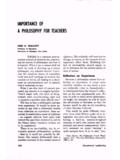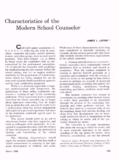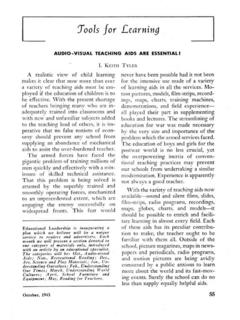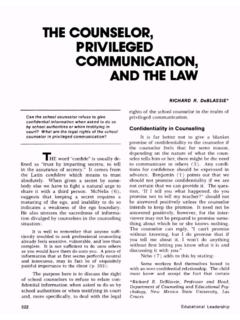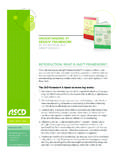Transcription of ELEMENTARY AND SECONDARY EDUCATION ACT - ascd.org
1 ELEMENTARY AND. SECONDARY . EDUCATION ACT. Comparison of the No Child Left Behind Act to the Every Student Succeeds Act Congress passed the Every Student Succeeds Act (ESSA) 1. to replace the No Child Left Behind Act (NCLB).2 This chart provides a breakdown of the differences between the two laws and highlights ascd 's position on key provisions. STANDARDS. No Child Left Behind Act Every Student Succeeds Act ascd position Requires state standards in reading, math, and sci- Requires assurance that states adopt challenging ence at all grade levels. academic content standards in reading, math, and science with three levels of achievement that are aligned with entrance requirements for credit- bearing coursework in the states' higher EDUCATION system as well as the state's career and technical EDUCATION standards. Prohibits the Secretary from having any authority over a state's academic standards. Each student deserves access to a credible, Allows states to develop standards in other content Allows states to adopt standards in other subjects.
2 Comprehensive, and well-rounded EDUCATION that areas. includes instruction in all academic content areas. States' standards, accountability systems, and public reporting of student performance must reflect these subjects. Requires states to apply the same academic stan- Allows states to develop alternate academic achieve- dards to all schools and children. ment standards for students with the most significant cognitive disabilities using a documented and validated standards-setting process. Capitol Connection, the ascd Educator Advocates weekly e-newsletter, provides you with the inside scoop related to Federal EDUCATION developments from Congress, the Department of EDUCATION , and the White House. Key EDUCATION issues, including assessment and accountability, school improvement, teacher effectiveness, and whole child EDUCATION . The latest national reports and research. 2. ASSESSMENTS. No Child Left Behind Act Every Student Succeeds Act ascd position Requires state testing in reading and math annually Same as NCLB but with the following changes: in grades 3 8 and once in high school.
3 Allows states to use a single annual summative assessment or multiple statewide interim assessments throughout the year that result in one summative score. Allows districts to use other tests for high schools with state permission. Allows states to develop and administer computer-adaptive assessments. Allows states to limit the aggregate amount of time spent on assessments for each grade. Prohibits the Secretary from specifying any aspect of assessments. Requires districts to publicly post information on all required assessments, including the amount of time students spend taking the assessments. Standardized tests help to provide a snapshot of Requires state testing in science annually in grade Same as NCLB. student performance, and results should continue spans 3 5, 6 8, and 10 12. to be disaggregated and reported publicly. However, student test scores provide an incomplete appraisal Allows states to develop assessments in other Same as NCLB. of student achievement and by themselves often subjects.
4 Offer a misleading depiction of student performance and school quality. Standardized tests alone should Requires states to provide reasonable adaptations Requires states to provide reasonable accommoda- never be used for high-stakes purposes, and neither and accommodations for students with disabilities. tions for students with disabilities. students nor educators nor schools should be ranked Allows states to administer alternate tests to Allows states to administer alternate tests for or rated based on test scores. students with disabilities; however, these alternate students with the most significant cognitive disabili- tests may be used by no more than 1% of the total ties; however, these alternate tests may be used by number of students being assessed. no more than 1% of the total number of students being assessed. Requires states to administer assessments to at least Maintains requirement that assessments be adminis- 95% of students and 95% of each student subgroup. tered to at least 95% of all students.
5 Allows states to establish their own laws governing opt-outs and requires parents to be notified regarding their children's participation rights in assessments. Consequences for schools that miss this threshold are determined by states and districts. Requires districts to annually assess all students with Shifts accountability for English language learners limited English language proficiency. into Title I; allows schools to phase in the use of English language learners' test results for account- ability purposes. Requires states and districts receiving Title I-A Same as NCLB. funds to annually administer National Assessment of Educational Progress tests in grades 4 and 8 in reading and math. 3. ACCOUNTABILITY. No Child Left Behind Act Every Student Succeeds Act ascd position Required that 100% of students be proficient Eliminates AYP and the 100% proficiency in reading and math by the end of school year requirement. 2013 14. Prohibits the Secretary from prescribing any aspect Requires that schools make adequate yearly of the accountability system, including indicators, progress (AYP) for all students and for subgroups for weighting, and differentiation methodology.
6 Which data are disaggregated. Requires state-developed accountability systems that Include performance goals for each subgroup, Standardized test scores alone should never be used Annually measure student performance based to evaluate students, educators, or schools. on state assessments, A new multimetric accountability model is needed For high schools: annually measure graduation that should rates, Incorporate all subjects, For ELEMENTARY and middle schools: annually Include nonacademic factors, measure student growth (or another valid and reliable statewide academic indicator), Use multiple measures of performance, Promote continuous improvement and support, Include one other indicator of school quality and or student success that allows for meaning- ful differentiation, such as student or educator Report community-level data to highlight shared engagement, or school climate and safety, responsibility for student success. For all English language learners: measure Although states should be given flexibility and English language proficiency annually in grades autonomy to design and implement their own 3 8 and once in high school, accountability systems, certain benchmarks should be collected and reported at each grade span Annually identify and differentiate schools based to ensure schools meet minimum performance on all indicators, and thresholds.
7 Differentiate schools in which any subgroup is consistently underperforming. Allows states to decide how much weight to give tests in their accountability systems and determine what consequences, if any, should attach to poor performance. Requires states to give more weight to academic factors than other factors. Establishes student subgroups for accountability Same as NCLB, with three additional subgroups for Public reporting of student achievement data in and data disaggregation, including students who are data reporting only: homeless status (if statistically disaggregated formats would allow transparency, economically disadvantaged, have limited English significant), students with parents in the military, and promote equity, hold appropriate stakeholders language proficiency, have disabilities, and belong students in foster care. accountable, and ensure shared responsibility for to major racial and ethnic groups as determined by student success. the state. continued on next page Get the latest EDUCATION news and share advocacy strategies with your peers.
8 JOIN Educator Advocates for the latest news and opportunities to take action. FOLLOW #ascdpolicy on Twitter and ascd 's blog, Inservice. JOIN the Educator Advocates conversation and share why advocacy is important with #EdAdvBecause. 4. ACCOUNTABILITY. No Child Left Behind Act Every Student Succeeds Act ascd position Requires publicly available annual state report card Requires publicly available annual state report card that includes that includes A description of the state accountability system, including Data on student achievement at each grade level all indicators and the weights assigned by the state, disaggregated by subgroup, Schools identified as in need of support and improvement, Comparison of state's actual achievement to its Student performance disaggregated by subgroup, objectives, State report cards should be made NAEP results, publicly available to provide aggregated Percentage of students not tested, Student participation rates in assessments, data on student and school performance.
9 State's achievement trends over the course of Public, user-friendly reporting of all Student performance on other academic indicators, two years, EDUCATION and student achievement Graduation rates, data in disaggregated formats, including Other indicators used to determine AYP, Performance of English language learners, resource allocations and funding levels, Graduation rates, Data collected pursuant to the Civil Rights Data will allow transparency, promote equity, Information on teacher quality, and and empower all interested parties to Collection survey, Other information as determined by the state. hold appropriate entities accountable for teacher qualifications, including those with emergency or provisional status, their responsibilities to children. Per-pupil expenditures of federal, state, and local funds, Number and percentages of students taking alternate assessments, and Postsecondary enrollment. SCHOOL IMPROVEMENT. No Child Left Behind Act Every Student Succeeds Act ascd position Triggers corrective action for schools that fail to meet Requires states, once every three years, to identify a category of AYP in consecutive years, with annually escalating schools for comprehensive support and improvement, including interventions.
10 At least the lowest-performing 5% of Title I schools, high schools with a graduation rate of 67% or less, and schools where one or Requires states to reserve up to 4% of Title I-A funds more subgroups of students are underperforming. to be available through the School Improvement Grant program. Allows districts to provide students in underperforming schools with the opportunity to transfer to another public school in the district, if permitted by the state. Requires districts to develop evidence-based strategies for school States and districts should be allowed improvement in partnership with parents and school staff that flexibility to implement improvement include all accountability indicators; requires districts to identify strategies, such as a whole child resource inequities. approach, and educator professional development should be a crucial compo- Eliminates the School Improvement Grant program but requires nent of such strategies. states to reserve 7% of Title I-A funds for school improvement activities, unless doing so results in a district receiving less Title I-A funding than in the previous year.

